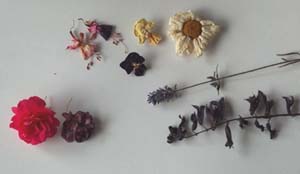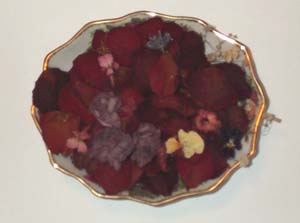


|
 |
elcome to crazyforLIFE(sm) -- the site for your whole life! |

Potpourri
If it smells good or looks pretty and you can dry it, you can make potpourri with it.
The beautiful and aromatic flowers and foliage of spring, summer, and fall can be preserved for you if you follow a few simple steps.
Getting Started
First, you need to collect your material for drying. If you have a garden, or access to one, pick blossoms that are just coming into full bloom in the morning after the dew has dried. Select any flower that you think is pretty and/or smells nice. Roses are a natural choice, but other flowers make wonderful additions to potpourri including pansies, daisies, anemones, impatiens, and fuschias. You can select flowers that are pretty even if they do not have a scent because they will look attractive in the potpourri. If you aren't sure how a flower will look, go ahead and pick one. If you are given a bouquet, you can save the flowers and dry them. Baby's breath, for example, makes a pretty addition to the top of a potpourri.

From top left: 2 fuschias, 2 pansies (yellow above,
purple below), daisy, lavender, purple salvia,
double impatiens, fresh and dried
Also collect aromatic leaves from herbs. Some excellent choices are rosemary, thyme, lemon thyme, lemon verbena, lemon balm, oregano, peppermint, and spearmint. You can also select pine needles and pick pine cones for a woodsy-scented potpourri.

Rosemary (top), oregano, thyme (all fresh)
Finally, depending upon the type of potpourri you wish to make, you can dry thin peels from citrus fruits. Lemons, limes, and oranges are especially useful. Also, pine cones and pine needles can be part of a woodsy potpourri.
Next is the drying of your flowers and leaves. Spread your selections out on paper toweling in a dry area out of direct sunlight. Keep the flowers and leaves in a single layer. You can pick petals off of larger flowers, such as roses, if you wish. Depending upon the thickness of the flower or leaf and the humidity, it will take 2 days to a week, or more, for the plant material to dry completely. Also note that flowers can look very different when dried; the dry double impatiens above is a mauve, the fresh flower is a dark pink-red.
Third, you want to purchase supplies for making your potpourri mix. You will need a fixative, spices, essential oils, and additional flowers or foliage to round out what you have collected. A fixative absorbs the volatile scented oils of the flowers, herbs, and other ingredients. It keeps the potpourri aromatic for a longer period of time. Some fixatives are orris root powder, gum benzoin, cinnamon, clove, nutmeg, sweet cicely seeds, and chamomile flowers. Essential oils are the concentrated oils from individual plants. They are sold in little bottles online and in herb and natural food stores. They vary in price; some essential oils are quite expensive. The two most commonly used in potpourris are rose oil and lavender oil. Other commonly used essential oils are lemon oil, bergamot oil, patchouli oil, and rosemary oil.

Bottle of lavender essential oil
Mixing Your Potpourri
Once all of your plant material is dried, and you have purchased your other ingredients, you are ready for the fun part -- mixing your potpourri. There are two types of potpourri, wet and dry. This article discusses making a dry potpourri. See below for a couple of recipes.
In a small bowl combine the ground spices, fixative, and essential oil. Thoroughly mix these ingredients to distribute the essential oil. In a separate, larger, bowl, combine the remaining dry ingredients (flowers, foliage, peels, etc.). If you are saving some flowers for decorating the top of your potpourri, set these aside.
Now add the small bowl with the spice, fixative, and oil mixture to the large bowl of dry ingredients. Mix thoroughly. Place the mixture in an airtight container and leave in a dark place for six weeks. Shake it every day for the first week.
After the mixture has matured, get out an attractive ceramic or glass bowl and add your potpourri mixture to it. Decorate the top with the flowers you saved. Periodically refresh your potpourri with a drop or two of essential oil.

Rose petal potpourri with decorative flowers
Recipes
For both these recipes, follow the directions under "Mixing Your Potpourri" above.
These two recipes are from the superb, but sadly out-of-print, book The Book of Potpourri: Fragrant Flower Mixes for Scenting & Decorating the Home.
Rich Rose Potpourri
1 quart rose petals and blooms
2oz lemon verbena
1oz lavender
2 teaspoons cinnamon powder
1oz orris root powder
1/2 teaspoon whole cloves
1/4 vanilla bean
5 drops rose oil
2 drops lavender oil
1 drop patchouli oil
rose blooms and leaves to decorate
Lemon Mix
2 cups lemon verbena
2 cups mixed scented geranium leaves, thyme, southernwood, meadowsweet flowers, and marjoram
2oz rosemary
1oz orris root powder
2 teaspoons cinnamon powder
1/2 teaspoon grated nutmeg
1/2 teaspoon whole cloves
1/4 vanilla bean
1oz lavender
a few pieces of orange and lemon peel
3 drops lemon oil
3 drops lavender oil
yellow flowers to decorate
Experiment with different flowers and foliage to find combinations you enjoy. Don't be afraid to try something new -- you may discover a delightful aroma.
Books
The following books will give you some ideas and instructions for creating great potpourris.
Potpourri and Fragrant Crafts
The Scented Room : Cherchez's Book of Dried Flowers, Fragrance, and Potpourri
Out of Print
The Book of Potpourri: Fragrant Flower Mixes for Scenting & Decorating the Home
by Penny Black
ISBN: 0671682105
You may be able to find this book in your library or through clicking on the link above.